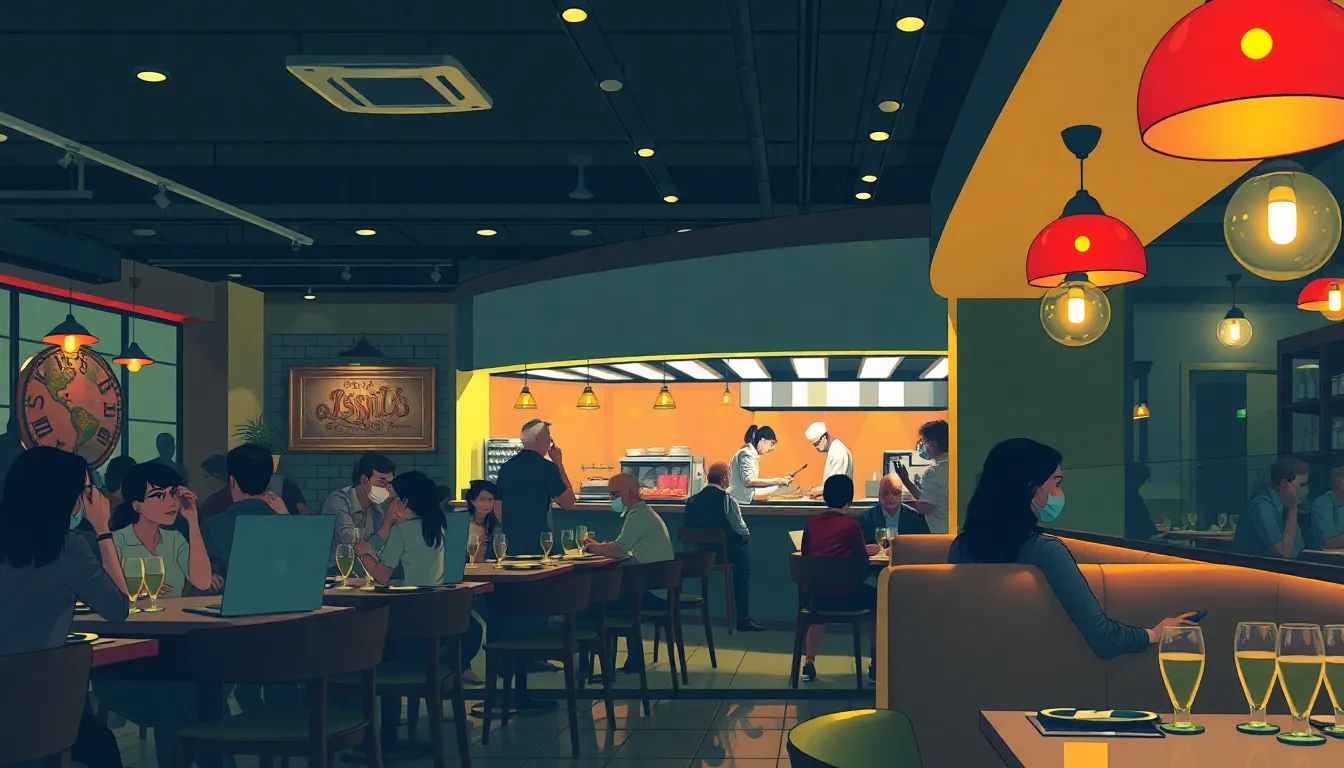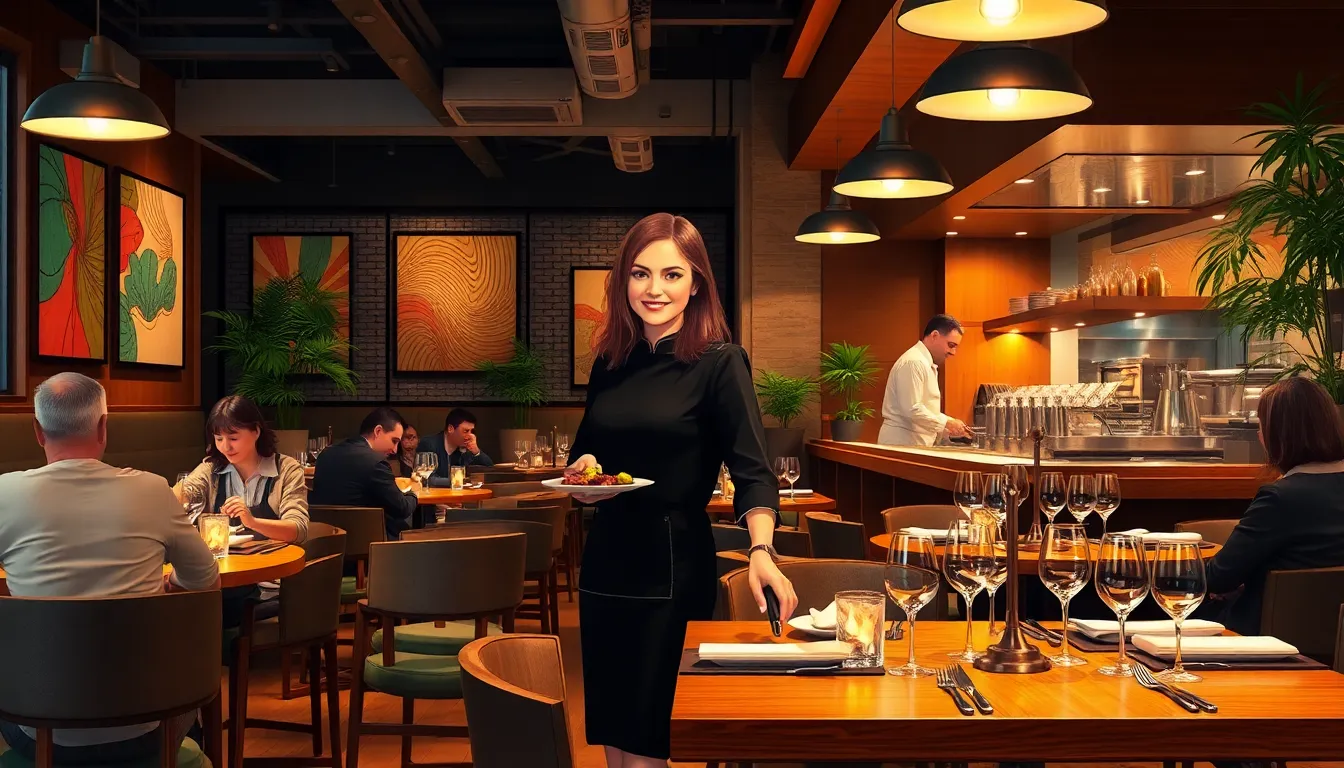In a world where first impressions matter more than ever, restaurant design is the secret ingredient that can turn a casual diner into a loyal patron. It’s not just about the food; it’s about creating an experience that tickles the senses and keeps guests coming back for more. Imagine walking into a place that feels like a cozy hug or a vibrant party—each design concept tells a story that entices diners to stay a little longer.
From rustic charm to sleek modernity, the right design can elevate any dining experience. Whether it’s the mood lighting that sets the stage or the quirky decor that sparks a conversation, every detail counts. Dive into the world of restaurant design concepts where creativity meets functionality, and discover how the perfect ambiance can transform a meal into a memorable adventure. After all, who wouldn’t want to feast in a place that feels like a work of art?
Table of Contents
ToggleOverview of Restaurant Design Concepts
Restaurant design concepts encompass various elements that significantly influence the dining experience. Ambiance sets the tone; it includes lighting, color schemes, and overall layout. Creating an inviting atmosphere engages customers, making them feel comfortable and welcomed.
Textures play a vital role in design concepts. Using wood, metal, or fabric can create a distinct feel within the same space. Each material contributes differently to the restaurant’s vibe, enhancing aesthetics and functionality.
Furniture selection impacts both comfort and flow. Choosing the right tables and chairs can dictate social interactions among diners. Arranging seating to promote conversation or privacy affects customers’ overall experience.
Theme consistency creates a coherent environment. Whether a restaurant focuses on modern minimalism or rustic charm, maintaining a unified theme ensures that all design elements work harmoniously. Effective themes attract target markets, making the dining experience more appealing.
Innovative designs enhance the functionality of the space. Open kitchens allow diners to view food preparation, creating a sense of transparency and trust. Outdoor seating expands capacity and attracts customers seeking fresh air during their meals.
Technology integration improves both service and ambiance. Smart lighting adjusts to the time of day, enhancing the overall dining experience. Additionally, digital menus streamline orders, providing convenience for both staff and patrons.
Sustainability increasingly influences design concepts. Eco-friendly materials and energy-efficient practices resonate with environmentally conscious customers. Incorporating plants and natural elements creates a fresh atmosphere, promoting well-being.
Overall, effective restaurant design concepts combine these elements to foster memorable dining experiences. Balancing aesthetics with functionality transforms a simple meal into a captivating adventure.
Importance of Effective Design

Effective restaurant design plays a critical role in cultivating memorable experiences for diners while enhancing operational efficiency. A well-executed design prioritizes elements that foster comfort and engagement.
Enhancing Customer Experience
Creating an inviting atmosphere directly influences customer satisfaction. Mood lighting shapes the emotional tone, while thoughtful layouts guide movement within the space. Textures, such as soft fabrics or polished wood, add tactile experiences that diners appreciate. Unique décor captures attention and encourages social interaction among patrons, making their visit more enjoyable. Besides visual appeal, seating arrangements promote conversation, helping diners feel more at ease. Integrating innovative features like open kitchens allows customers to observe meal preparation, further enhancing their connection to the dining experience.
Impact on Brand Identity
Effective design solidifies a restaurant’s brand identity in competitive markets. The atmosphere reflects the type and quality of cuisine offered, influencing customer perceptions. Consistency in visual elements, from color schemes to furniture choices, reinforces brand messaging and values. Unique themes or innovative layouts distinguish a restaurant from others, creating lasting impressions. Technology, like digital menus, showcases modernity while aligning with target demographics. Sustainable materials resonate with environmentally conscious consumers, enhancing brand loyalty. Overall, a cohesive design resonates with customers and strengthens brand identity.
Key Elements of Restaurant Design
Effective restaurant design integrates several key elements that enhance the dining experience. A well-planned approach focuses on layout, lighting, color schemes, and materials to create a memorable atmosphere.
Layout and Flow
Effective layout facilitates smooth movement throughout the space. Open designs encourage interaction between diners and staff, creating an inviting atmosphere. Diners appreciate clear pathways that prevent congestion. Strategic placement of furniture promotes social interaction while maintaining comfort. The arrangement of seating options influences diners’ experiences, whether it’s a cozy booth for two or communal tables for larger groups. An organized layout directly impacts operational efficiency as staff navigate through the dining area seamlessly.
Lighting and Ambiance
Appropriate lighting sets the mood and influences the overall experience. Soft, warm lighting creates a relaxed environment, ideal for intimate dinners. Alternatively, brighter lighting suits casual or fast-paced dining settings. Flexible lighting options, such as dimmers, enhance versatility for different occasions. Unique fixtures contribute character, incorporating thematic elements that resonate with customers. Ambiance plays a significant role in shaping emotions and enhancing customer satisfaction.
Color Schemes and Materials
Colors evoke specific feelings and associations, influencing diners’ perceptions. Warm tones, such as reds and oranges, stimulate appetite, while cool colors create a calming effect. Materials also contribute to the overall aesthetic; wood offers warmth, while metal brings a modern edge. Combinations of textures further enrich the space, providing visual interest. Cohesive color schemes and carefully selected materials ensure a unified theme, reinforcing brand identity and attracting target markets.
Popular Restaurant Design Styles
Various styles of restaurant design capture distinct atmospheres, shaping the overall dining experience. Understanding these popular concepts helps create memorable environments for patrons.
Modern Minimalism
Modern minimalism emphasizes simplicity and functionality. Clean lines and uncluttered spaces prevail in this design style, allowing focus on the dining experience. Neutral color palettes enhance the ambiance, while natural materials like wood and stone add warmth. Lighting, often understated, creates a welcoming glow. Seating arrangements promote comfort without excess, allowing diners to engage fully with their meals and fellow guests. This approach resonates particularly well with urban eateries that appeal to a contemporary clientele.
Rustic Charm
Rustic charm evokes a sense of warmth and nostalgia. Exposed brick walls, wooden beams, and vintage decor create an inviting atmosphere. Natural elements like plants and soft textiles complement the earthy tones found in furniture and fixtures. This design style draws inspiration from traditional farmhouses, prioritizing comfort and familiarity. Space often includes cozy nooks for intimate gatherings, fostering social interaction. Dining experiences within this environment feel relaxed, encouraging guests to linger and savor their meals.
Eclectic Mix
Eclectic mix embraces diversity and individuality. This style combines various design elements from different eras and cultures, creating a vibrant atmosphere. Colorful artwork, unique furniture, and mismatched decor showcase personal expression and creativity. The layout encourages exploration, inviting diners to discover new spots within the restaurant. Varied seating options accommodate different preferences, fostering dynamic interactions. Restaurants adopting this style attract adventurous patrons, eager to enjoy unique culinary experiences in an inspiring setting.
Restaurant design goes beyond aesthetics; it shapes the entire dining experience. A well-crafted atmosphere not only attracts customers but also keeps them coming back. By focusing on elements like layout, lighting, and materials, restaurants can create unique spaces that resonate with their target audience.
As trends evolve, integrating technology and sustainability into design will become increasingly important. These factors not only enhance functionality but also align with the values of modern diners. Ultimately, a thoughtful design approach can turn a meal into an unforgettable adventure, reinforcing brand identity while fostering customer loyalty.

